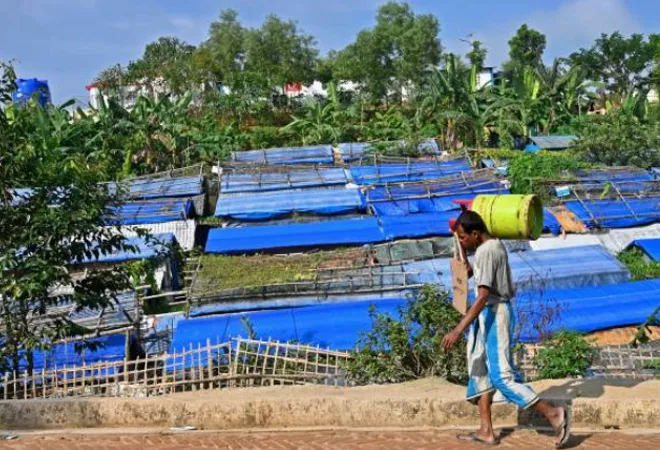-
CENTRES
Progammes & Centres
Location
As a proper resolution of the Rohingya crisis is nowhere in sight, adequate measures need to be undertaken to provide Rohingyas with a suitable environment to live in

As the hearing on the Rohingya genocide case is set for 21 February at the International Court of Justice (ICJ), Myanmar's Junta is now expected to challenge the allegations that the country committed genocide against its Rohingya population. This throws a lot of uncertainty towards the earlier ruling, which had hoped to create a proper solution for the stateless people who are currently living in Myanmar and Bangladesh.
The ICJ verdict of 2019 brought about immense relief and hope to the Government of Bangladesh, which is currently catering to around a million Rohingyas residing in 34 camps at Cox’s Bazar district. The country has been suffering from a lack of space and funds for four years now. Bangladesh has already been at the receiving end of the conflict, with two failed repatriations and the February 2021 coup that has made matters more uncertain towards the creation of a conducive environment for the safe and dignified repatriation of Rohingyas to Rakhine State.
This move particularly tosses ambiguity over the future of 451,612 children below the age of 18 years living in the camp areas in Bangladesh. The conditions of the camps remain unchanged and have worsened as the New Year arrived. The sudden fires, which affected Camp 16 and other areas, have created panic and fear amongst the displaced people, especially children living in Balukhali and Kutupalong camps. Within the first nine days of the New Year 2022, two bouts of fire have ravaged more than 600 shelters and have displaced close to 3,600 people, out of whom 750 are children.
The sudden fires, which affected Camp 16 and other areas, have created panic and fear amongst the displaced people, especially children living in Balukhali and Kutupalong camps.
Fires within the camp areas have been rampant for the past two years. 2021 witnessed frequent instances of fire incidents, close to 100 in the first seven months. The major fire in March 2021 killed around 15 people and destroyed over 10,000 shelters, displacing more than 50,000 hapless people.
Since the camp areas are supposed to be semi-permanent, the shelters are built with tarpaulins and bamboo, which are easily combustible. While the source of the current fire remains unknown, this time, seven children have been injured. They are being provided with proper medical assistance.
Every day, children within the camps are seen to be waiting for aid handouts, carrying jugs of water or bundles of firewood on their heads, or playing in cramped spaces of land. While some are dressed in tattered clothes, most are without any proper clothes. They have experienced severe trauma, both physical and mental, while they resided in Myanmar. Most of them witnessed their loved ones being beaten, violated, or murdered by Junta forces. They have barely escaped death while fleeing from the military forces, making the incredibly difficult journey to Bangladesh.
Doctors Without Borders estimates that at least 730 Rohingya children younger than five years old were killed mostly by gunshots, 10 percent were burnt, and 5 percent were beaten to death in Myanmar within a month before the major exodus took place in 2017. Such numbers reveal only a handful of actual instances, while the original figure remains higher than expected, with many never coming to the surface.
Doctors Without Borders estimates that at least 730 Rohingya children younger than five years old were killed mostly by gunshots, 10 percent were burnt, and 5 percent were beaten to death in Myanmar within a month before the major exodus took place in 2017.
Seventeen percent, i.e., over 80,000 children surviving in the camp areas are estimated to be undergoing severe mental distress. Fire incidences in the last year left several children traumatised . It brought back ghastly memories from when their houses were burnt or their loved ones were burnt alive. Children experiencing severe mental distress without adequate support can feel anxious, become withdrawn, grow aggressive, and can be sucked into hopelessness and depression. They are being given consistent psychological support by the experts within the aid organisations to overcome such a state of mind. Aid agencies fear relapses of such dreadful memories.
In addition to this, the fire has also created food insecurity issues. Many shelters have been burnt down to ashes leaving no scope for the people to get away with valuables. Many have lost their savings in the process and are left with no money to purchase even necessities like ration or clothes. Malnutrition amongst Rohingya children remains high due to a low nutrition diet while they scraped for their existence in Myanmar. In 2019, out of the 163,200 children below the age of five, only 24,500 children with Severe Acute Malnutrition have been admitted for treatment in health centres run within the camp areas while more remain in need. In a new initiative from 2020 onwards, all nutrition services have been provided through 46 integrated nutrition facilities (INF), which has significantly improved the severe wasting rates. The wasting and stunting have come down from 2.4 percent in 2018 to 0.6 percent in 2020. However, the proportion of children under five years of age screened and identified with moderate wasting did not vary from before and after the nutrition service rationalisation. Thus, more needs to be done in this area.
Children experiencing severe mental distress without adequate support can feel anxious, become withdrawn, grow aggressive, and can be sucked into hopelessness and depression.
Furthermore, four learning centres have been dented, further challenging the already inadequate educational opportunities that limit the future growth of children. More than 200 WASH facilities have been damaged, impacting the sanitation and hygiene amenities in the current COVID times.
Some mechanisms are in place to tackle the unwarranted situation. Humanitarian organisations like UNHCR, UNICEF, World Food Program, and Save the Children under the leadership of the Bangladesh government have arranged several initiatives to control nutrition issues.
After the recent fire, World Food Program and its national NGO partner Resource Integration Centre (RIC) distributed biscuits to around 1,600 people who had lost their homes or cooking equipment. The organisation is also distributing hot meals twice daily to all the families left with no means to cook until shelters and cooking equipment are restored. Families will then be reintegrated into WFP’s regular food assistance program.
Digital beneficiary management systems are being worked out amongst humanitarian partners to support the coordination of the delivery of non-food items, such as cooking gas, especially to those displaced persons who have lost their documents in the fire.
Digital beneficiary management systems are being worked out amongst humanitarian partners to support the coordination of the delivery of non-food items, such as cooking gas, especially to those displaced persons who have lost their documents in the fire. Volunteers are also deployed in the field to support the clearance of debris.
Blankets and mosquito nets have been distributed to families who have been left homeless. Save the Children and UNICEF are coordinating with their staff to identify children lost in the chaos and working to reunify them with their families.
To mitigate space issues for rebuilding shelters with adequate measures for safety, UNHCR and partners have introduced double-story shelters to make use of limited space and to ensure space for fire breaks, in consultation with the authorities. Although the government has approved the construction of double-story shelters in some of the camps, the building of more two-story structures remains essential.
Many displaced people brought to the fore the problems with the fencing system, which obstructs swift evacuation efforts and aid supplies in times of emergencies.
While few changes are awaited, more are required to ensure security within the camp areas. For instance, housing in the camps should be made with less flammable objects like bricks and tin. One deep motor tube well with long pipes could be set up in each block of the camps for use during an emergency. Also, many displaced people brought to the fore the problems with the fencing system, which obstructs swift evacuation efforts and aid supplies in times of emergencies. Besides, proper security is required in the evening and at night to ensure that such crime is kept at a low.
While it was thought that last year was a lesson for the stakeholders to upgrade the shelters and surroundings to make them resistant to future fire attacks, the current situation shows a need for better planning and concrete actions to deal with sudden occurrences. The Myanmar coup and the resulting crisis have put the lives of the Rohingya children in limbo with no sight of returning to normalcy in the near future. It, thus, becomes necessary to provide them with innocuous settlements where they feel safe till proper solutions can be worked out.
The views expressed above belong to the author(s). ORF research and analyses now available on Telegram! Click here to access our curated content — blogs, longforms and interviews.

Sreeparna Banerjee is an Associate Fellow in the Strategic Studies Programme. Her work focuses on the geopolitical and strategic affairs concerning two Southeast Asian countries, namely ...
Read More +